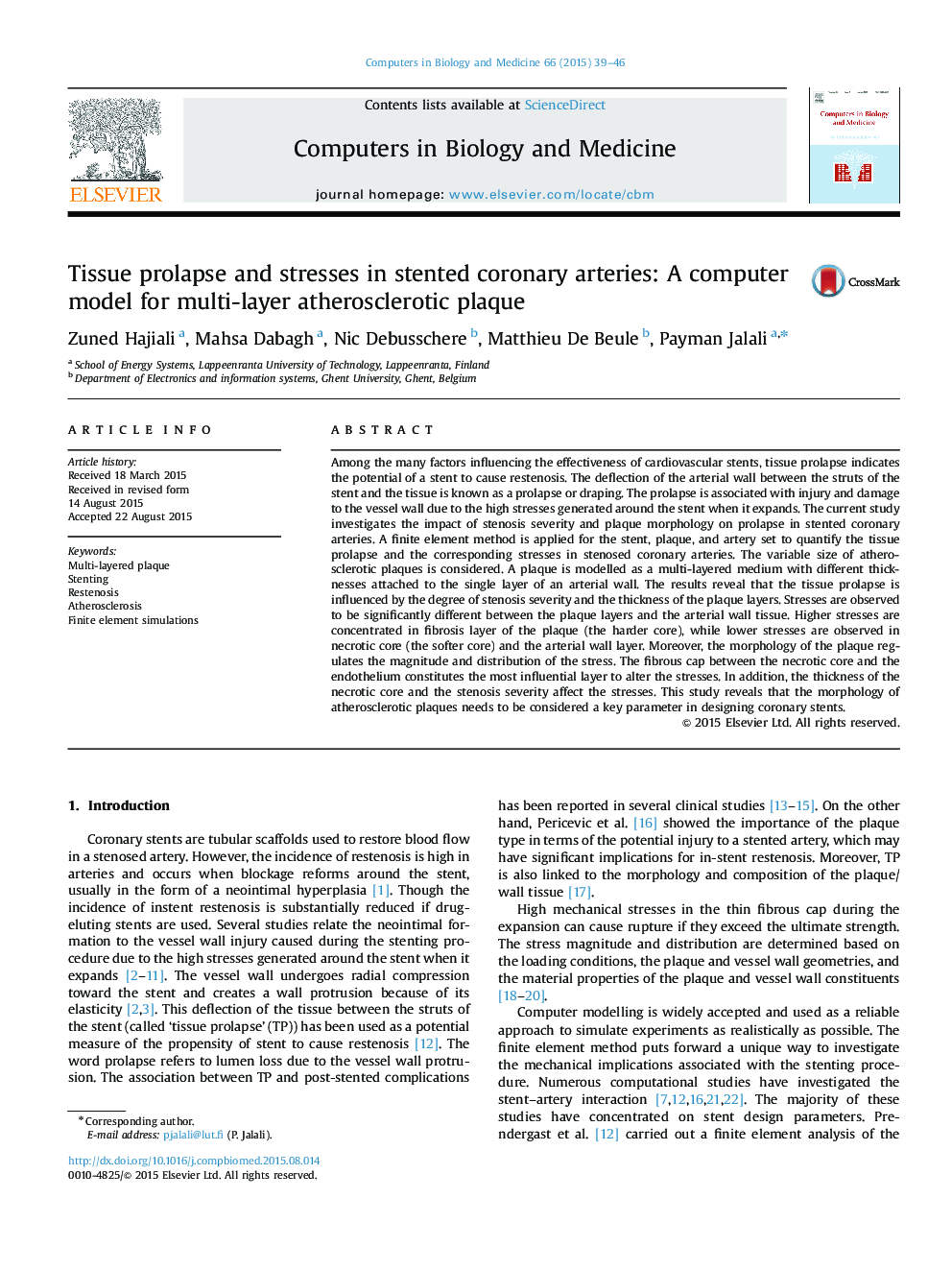| کد مقاله | کد نشریه | سال انتشار | مقاله انگلیسی | نسخه تمام متن |
|---|---|---|---|---|
| 6921076 | 864443 | 2015 | 8 صفحه PDF | دانلود رایگان |
عنوان انگلیسی مقاله ISI
Tissue prolapse and stresses in stented coronary arteries: A computer model for multi-layer atherosclerotic plaque
ترجمه فارسی عنوان
پرولاپس بافتی و تنش در شریان های عصبی مصنوعی: یک مدل کامپیوتری برای پلاک آترواسکلروز چند لایه
دانلود مقاله + سفارش ترجمه
دانلود مقاله ISI انگلیسی
رایگان برای ایرانیان
کلمات کلیدی
پلاک چند لایه استنت تنفس آترواسکلروز، شبیه سازی عنصر محدود
ترجمه چکیده
در میان بسیاری از عوامل موثر بر اثربخشی استنت های قلبی عروقی، پرولاپس بافت، پتانسیل استنت را برای ایجاد استنشاع نشان می دهد. انحراف دیواره شریانی بین ستون ها و بافت ها به عنوان پرولاپس یا پرده بینی شناخته می شود. پرولاپس با آسیب و آسیب به دیواره عروق به علت استرس های بالا ایجاد شده در اطراف استنت در هنگام گسترش آن است. مطالعه حاضر به بررسی تأثیر شدت تنفسی و مورفولوژی پلاک در پرولاپس در شریان های عروق کشیده شده است. یک روش عنصر محدود برای استنت، پلاک و عروق برای اندازه گیری پرولاپس بافت و تنش های مرتبط با آن در شریان های کرونر استنستی استفاده می شود. اندازه متغیر پلاکهای آترواسکلروتیک در نظر گرفته شده است. یک پلاک به عنوان یک محیط چند لایه با ضخامت های مختلف متصل به لایه ی تک دیواره شریانی مدل سازی می شود. نتایج نشان می دهد که پرولاپس بافت تحت تاثیر میزان شدت تنفس و ضخامت لایه های پلاک قرار گرفته است. مشاهده می شود که تنش ها بین لایه های پلاک و بافت های دیواره شریانی تفاوت قابل توجهی دارند. استرس های بالاتر در لایه فیبروز پلاک (هسته سخت تر) متمرکز می شوند، در حالی که استرس های پایین در هسته نکروتیک (هسته نرمتر) و لایه دیوار شریانی مشاهده می شود. علاوه بر این، مورفولوژی پلاک مقادیر و توزیع استرس را تنظیم می کند. چگالی فیبر بین هسته نایروتیک و اندوتلیوم، لایه ای تاثیر گذار برای تغییر تنش ها است. علاوه بر این، ضخامت هسته نکروتیک و شدت تنفس نیز بر تنش تاثیر می گذارد. این مطالعه نشان می دهد که مورفولوژی پلاک های آترواسکلروز باید یک پارامتر کلیدی در طراحی استنت های کرونر باشد.
موضوعات مرتبط
مهندسی و علوم پایه
مهندسی کامپیوتر
نرم افزارهای علوم کامپیوتر
چکیده انگلیسی
Among the many factors influencing the effectiveness of cardiovascular stents, tissue prolapse indicates the potential of a stent to cause restenosis. The deflection of the arterial wall between the struts of the stent and the tissue is known as a prolapse or draping. The prolapse is associated with injury and damage to the vessel wall due to the high stresses generated around the stent when it expands. The current study investigates the impact of stenosis severity and plaque morphology on prolapse in stented coronary arteries. A finite element method is applied for the stent, plaque, and artery set to quantify the tissue prolapse and the corresponding stresses in stenosed coronary arteries. The variable size of atherosclerotic plaques is considered. A plaque is modelled as a multi-layered medium with different thicknesses attached to the single layer of an arterial wall. The results reveal that the tissue prolapse is influenced by the degree of stenosis severity and the thickness of the plaque layers. Stresses are observed to be significantly different between the plaque layers and the arterial wall tissue. Higher stresses are concentrated in fibrosis layer of the plaque (the harder core), while lower stresses are observed in necrotic core (the softer core) and the arterial wall layer. Moreover, the morphology of the plaque regulates the magnitude and distribution of the stress. The fibrous cap between the necrotic core and the endothelium constitutes the most influential layer to alter the stresses. In addition, the thickness of the necrotic core and the stenosis severity affect the stresses. This study reveals that the morphology of atherosclerotic plaques needs to be considered a key parameter in designing coronary stents.
ناشر
Database: Elsevier - ScienceDirect (ساینس دایرکت)
Journal: Computers in Biology and Medicine - Volume 66, 1 November 2015, Pages 39-46
Journal: Computers in Biology and Medicine - Volume 66, 1 November 2015, Pages 39-46
نویسندگان
Zuned Hajiali, Mahsa Dabagh, Nic Debusschere, Matthieu De Beule, Payman Jalali,
